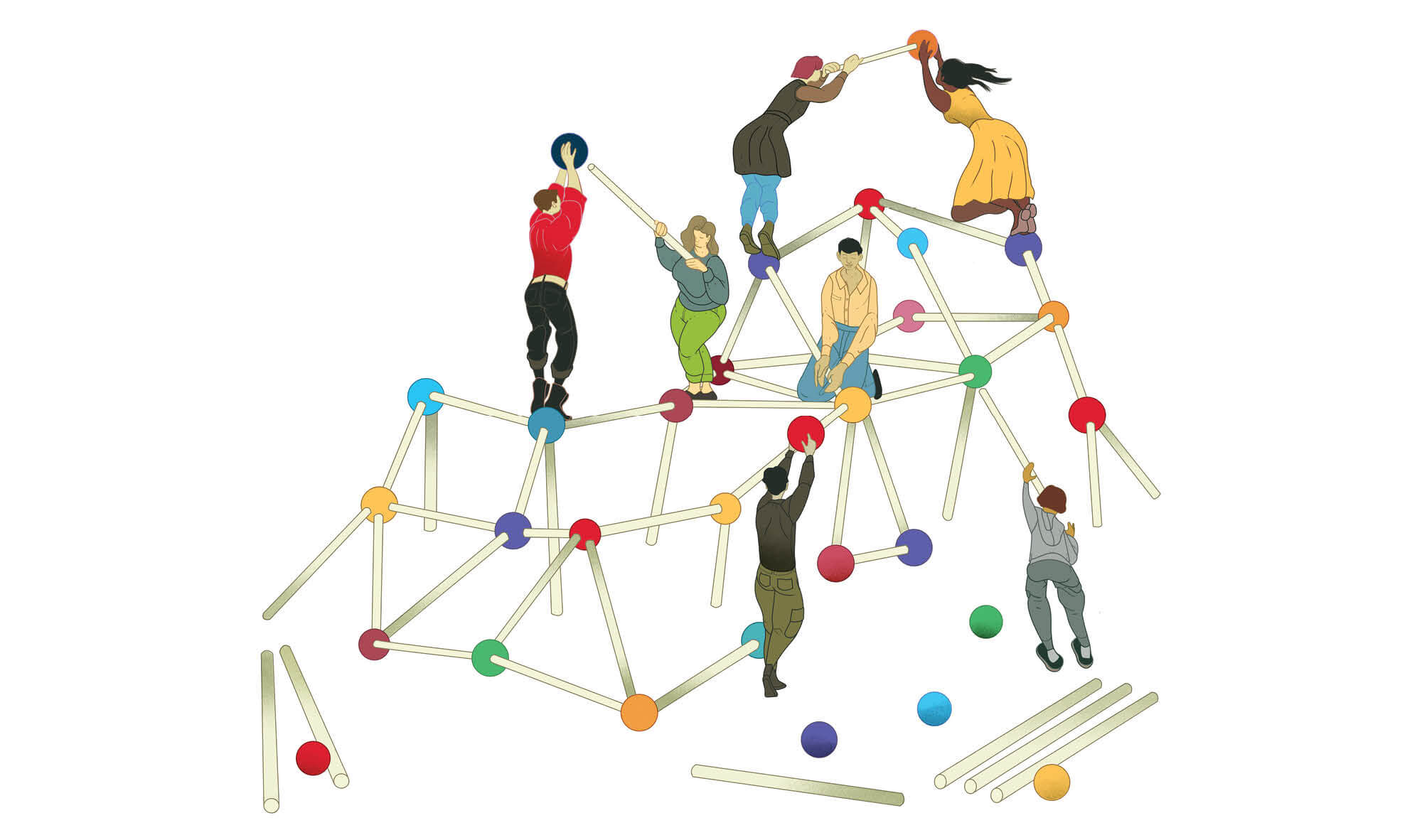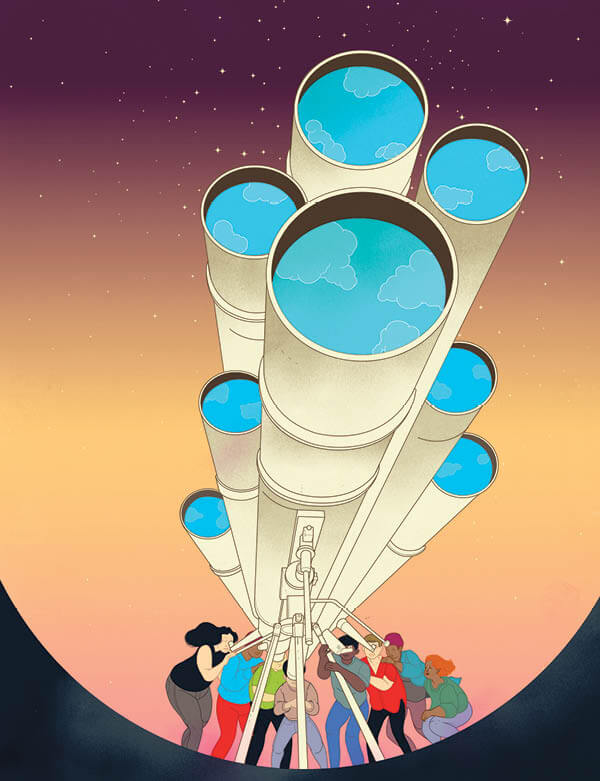Evolving your company culture for the new world of work.
For Sarah Tait, MBA 16 (shown below), not a lot changed when COVID-19 lockdowns first upended the world of work two years ago. Her company, Branch International, provides financial services to emerging countries, so its roughly 200 employees were distributed across the globe. They were used to connecting, coordinating, and collaborating online—often asynchronously. The hard part came later, says Tait, the company’s chief people officer, as Branch’s customers, mostly entrepreneurs, stopped seeking or repaying microloans.
 Branch’s business soon stalled, forcing layoffs and an intensive focus on conserving cash. As the company used the downtime to innovate and work on new product launches, Tait and her team started surveying employees through frequent polls and focus groups, signaling a new approach to managing company culture.
Branch’s business soon stalled, forcing layoffs and an intensive focus on conserving cash. As the company used the downtime to innovate and work on new product launches, Tait and her team started surveying employees through frequent polls and focus groups, signaling a new approach to managing company culture.
The feedback helped her keep tabs on employee sentiment. She and her team ran wellness workshops and a “burnout clinic” for engineers and product managers to share ideas on how to separate work from personal life. Branch also instituted a monthly mental health day: The entire company shuts down and stays off Slack and email. Food delivery gift cards are sent to employees to encourage them to log on for synchronous “eat and learn” get-togethers with colleagues—whether they’re eating breakfast in the Bay Area, a late-afternoon snack in Nigeria, or dinner in India.
Today, Branch’s revenues and employee count have bounced back, but Tait says the hard work is just beginning. The company looks different today than it did two years ago, and pressure is mounting to make decisions that had been put off: What does the future of work look like for Branch? And what does that future mean for company culture?
“Now more than ever,” says Tait, “the importance of culture is front and center for us.”
It is for a lot of companies.
The search for purpose
 Professor Jennifer Chatman, PhD 88 (shown right), a leading researcher in organizational culture, says that in the first phase of the pandemic, executives and managers were focused on urgent operational matters—like keeping workers safe and healthy, ensuring that remote workers had the resources to get their jobs done, and managing severe disruptions to global supply chains. “Most business leaders have prioritized supporting their people during these uncertain times,” says Chatman, the Paul J. Cortese Distinguished Professor of Management and associate dean for academic affairs.
Professor Jennifer Chatman, PhD 88 (shown right), a leading researcher in organizational culture, says that in the first phase of the pandemic, executives and managers were focused on urgent operational matters—like keeping workers safe and healthy, ensuring that remote workers had the resources to get their jobs done, and managing severe disruptions to global supply chains. “Most business leaders have prioritized supporting their people during these uncertain times,” says Chatman, the Paul J. Cortese Distinguished Professor of Management and associate dean for academic affairs.
By necessity, culture took a back seat for many business leaders. Some simply hoped their existing workplace ethos would migrate easily to an online world. It hasn’t worked out that way, say Haas faculty and alumni interviewed for this story. Untethered from the physical office, remote employees now transact—they don’t bond, says Homa Bahrami, a senior lecturer and expert on organizational behavior.
“There has been a cultural dilution, a weakening of the glue that holds companies together,” says Bahrami. No company has been immune, she says, and the implications for productivity, collaboration, innovation, and sense of belonging are profound.
The evidence of that cultural weakening is mounting. Americans voluntarily quit a record 47.4 million jobs in 2021. “Employees are missing the unique ways that they interact with co-workers making up organizational culture,” Chatman says. “Without these distinctions, employees are hard-pressed to feel great loyalty to one organization over another.”

 Recently, Chatman and Professor Sameer Srivastava co-authored a study finding that companies are performing well on just one of 10 attributes associated with workplace culture: communication. A separate 2021 study co-authored by Assistant Professor David Holtz, of 61,000 Microsoft employees working remotely during the pandemic, uncovered drawbacks for collaboration across formal and informal teams. And a report from the Society for Human Resource Management revealed that 62% of managers were finding it difficult to create and sustain workplace culture.
Recently, Chatman and Professor Sameer Srivastava co-authored a study finding that companies are performing well on just one of 10 attributes associated with workplace culture: communication. A separate 2021 study co-authored by Assistant Professor David Holtz, of 61,000 Microsoft employees working remotely during the pandemic, uncovered drawbacks for collaboration across formal and informal teams. And a report from the Society for Human Resource Management revealed that 62% of managers were finding it difficult to create and sustain workplace culture.
“As business leaders make strategic decisions about their workplaces and what they will look like, it’s imperative that they stay open about their strategic opportunities and consider evolving their company cultures to execute on new priorities.”
—Prof. Jennifer Chatman
 Kavita Vora, MBA 09 (shown left), the chief people officer at online education company BrainPOP, says business leaders are discovering that pre-pandemic cultures don’t always translate to the new world of work—and that’s an important realization. “It’s a little bit daunting for business leaders to think about, ‘Am I okay with letting the culture evolve, even if I liked the old culture and knew it worked?’” says Vora. “But we have a golden opportunity to keep our employees engaged by approaching this moment with a growth mindset.”
Kavita Vora, MBA 09 (shown left), the chief people officer at online education company BrainPOP, says business leaders are discovering that pre-pandemic cultures don’t always translate to the new world of work—and that’s an important realization. “It’s a little bit daunting for business leaders to think about, ‘Am I okay with letting the culture evolve, even if I liked the old culture and knew it worked?’” says Vora. “But we have a golden opportunity to keep our employees engaged by approaching this moment with a growth mindset.”
Embracing transformation is crucial, says Chatman. One of her many groundbreaking insights has shown that companies with cultures that are strong, strategically aligned, and adaptable to rapidly changing business climates perform 15% better than those with weaker or less adaptable cultures.
“As business leaders make strategic decisions about their workplaces and what they will look like, it’s imperative that they stay open about their strategic opportunities and consider evolving their company cultures to execute on new priorities,” says Chatman, who also co-directs the Berkeley Culture Initiative with Srivastava, the Ewald T. Grether Chair in Business Administration and Public Policy.
The Clorox Company offers a useful lesson in adaptability, says Chatman. The 109-year-old consumer goods giant spent years infusing boldness and agility into its decision-making at all levels. That investment paid off early in the pandemic when, for example, it moved quickly to ramp up production of its disinfecting wipes while also protecting factory workers.
 “It helped us that we were shifting in the right direction, culturally, prior to the pandemic,” says Hilda West, MBA 92 (shown right), the vice president of talent and culture at Clorox until her retirement last year. “We were able to say, ‘Okay, we’ve got this. We know how to do this faster.’”
“It helped us that we were shifting in the right direction, culturally, prior to the pandemic,” says Hilda West, MBA 92 (shown right), the vice president of talent and culture at Clorox until her retirement last year. “We were able to say, ‘Okay, we’ve got this. We know how to do this faster.’”
Universal challenges
The coronavirus pandemic is not the only force causing workplace upheaval. The May 2020 murder of George Floyd and the Black Lives Matters protests that followed, along with minorities being disproportionately impacted by the pandemic, have made many companies take a hard look at how their own practices may be contributing to deep-seated racial inequality. Chatman and Srivastava’s 2021 study, for example, found that members of minority groups view their company cultures more negatively and feel less optimistic about the future than their white peers.
The verdict is out on how hybrid work—and its unintended consequences—will impact those feelings. Surveys have shown that many members of minority groups say they are happier to be freed from daily microaggressions at the office. But another concern is proximity bias, which holds that workers who are physically closer to the boss are at an advantage.
 “If I’m a member of an underrepresented group who is way more comfortable working from home, am I then making a trade-off in my career potential?” says Cynthia Owyoung, BS 94 (shown right), the vice president of inclusion, equity, and belonging at financial services firm Robinhood and author of All Are Welcome: How to Build a Real Workplace Culture of Inclusion that Delivers Results.
“If I’m a member of an underrepresented group who is way more comfortable working from home, am I then making a trade-off in my career potential?” says Cynthia Owyoung, BS 94 (shown right), the vice president of inclusion, equity, and belonging at financial services firm Robinhood and author of All Are Welcome: How to Build a Real Workplace Culture of Inclusion that Delivers Results.
Solving for culture
The risk to any culture in the new world of work boils down to a loss of connection—across all levels of the organization. But there are steps that all business leaders can take to reinforce a sense of belonging.
One solution is by crafting the company narrative to reflect shared experiences over the last two years. In her research, Professor Laura Kray has shown how stories that companies relay about their earliest days motivate employees.
“The sense that ‘We almost didn’t make it’ inspires counterfactual thinking, or ‘if-only thoughts,’ of what might have been if the company hadn’t survived and can be a boon for creativity, commitment, and feelings of gratitude,” says Kray, The Ned and Carol Spieker Chair in Leadership. The pandemic, she says, is an opportunity for companies to both recognize real losses while also letting employees know that “at this point, we’re all COVID survivors, and we’re all trying to figure out what comes next.”
“The pandemic is an opportunity for companies to both recognize real losses while also letting employees know that “at this point, we’re all COVID survivors, and we’re all trying to figure out what comes next.”
—Prof. Laura Kray
 Executives and managers also need to think differently about what it means to lead, says Haas’ Bahrami. They have to think like scientists, test new ways of working, and embrace trial and error. What’s more, they need to be open with employees that culture is a work in progress. Above all, even though workplace culture is undergoing a massive disruption, it’s important to be deliberate.
Executives and managers also need to think differently about what it means to lead, says Haas’ Bahrami. They have to think like scientists, test new ways of working, and embrace trial and error. What’s more, they need to be open with employees that culture is a work in progress. Above all, even though workplace culture is undergoing a massive disruption, it’s important to be deliberate.
“Take baby steps,” says Bahrami, also a faculty director for Berkeley Executive Education. “Experiment, fail, learn, and iterate, just like Thomas Edison did a thousand times before he invented the lightbulb.”
One example of a baby step that paid off: Tamara Brown, a manager at Adobe, created a “mistake of the month” conversation during virtual meetings with her global team of project managers. She kicked it off by describing a recent mistake she’d made and what she’d learned from it. Next, she invited employees to share a mistake. “Complete crickets,” she recalls. She intentionally didn’t bring it up at the next team meeting but tried again at the one after. After describing a fresh mistake she’d made, someone else spoke up—and the conversation took off.
Brown didn’t just create a safe space for employees. Open discussions of mistakes as well as successes in meetings have also helped her identify operational challenges. “These rich conversations have dramatically increased our ability to manage and uncover patterns of risk,” says Brown, who is based in Ontario, Canada, and took one of Bahrami’s Executive Education classes. Brown’s iteration: “Mistake of the month” is now “opportunity of the month.”
embracing uncertainty
Brown is leading her team exactly how Chatman and other Haas experts say all business leaders should: by embracing uncertainty, keeping an open mind while being realistic about the future, and signaling empathy and support—whether it’s providing the right technology tools or speaking openly about mental health.
“It’s really about demonstrating respect and recognizing the value of allowing employees to be co-creators of your culture and the climate that will be the most conducive to their productivity.”
—Jill Vialet, Haas visiting scholar
“People talk about empowerment,” says Jill Vialet, a social entrepreneur and visiting scholar at Haas who is an expert on the power of play at work. “But it’s really about demonstrating respect and recognizing the value of allowing employees to be co-creators of your culture and the climate that will be the most conducive to their productivity.”
For BrainPOP’s Vora, this meant surveying employees on how well they thought the company was living by its work values every day. Employees gave the company high marks for leading with empathy, one of the company’s formative values, but said that communication was harder in a hybrid model. They also felt that too many tools and processes had been introduced for hybrid work; they craved more simplicity. “We spent a lot of time weighing the value of giving people unlimited choice to do their work in the way they see best, or simplifying work processes so it’s easier to make decisions,” says Vora. The team ultimately decided to implement a single project management platform companywide to streamline communication and collaboration.
This is one of many ways BrainPOP is giving employees a voice in how its culture evolves. To Vora, business leaders who are thinking about how their workplace will look and function going forward shouldn’t try to force fit their old culture into the new environment.
“Take a risk and embrace where the culture wants to move,” she says.
